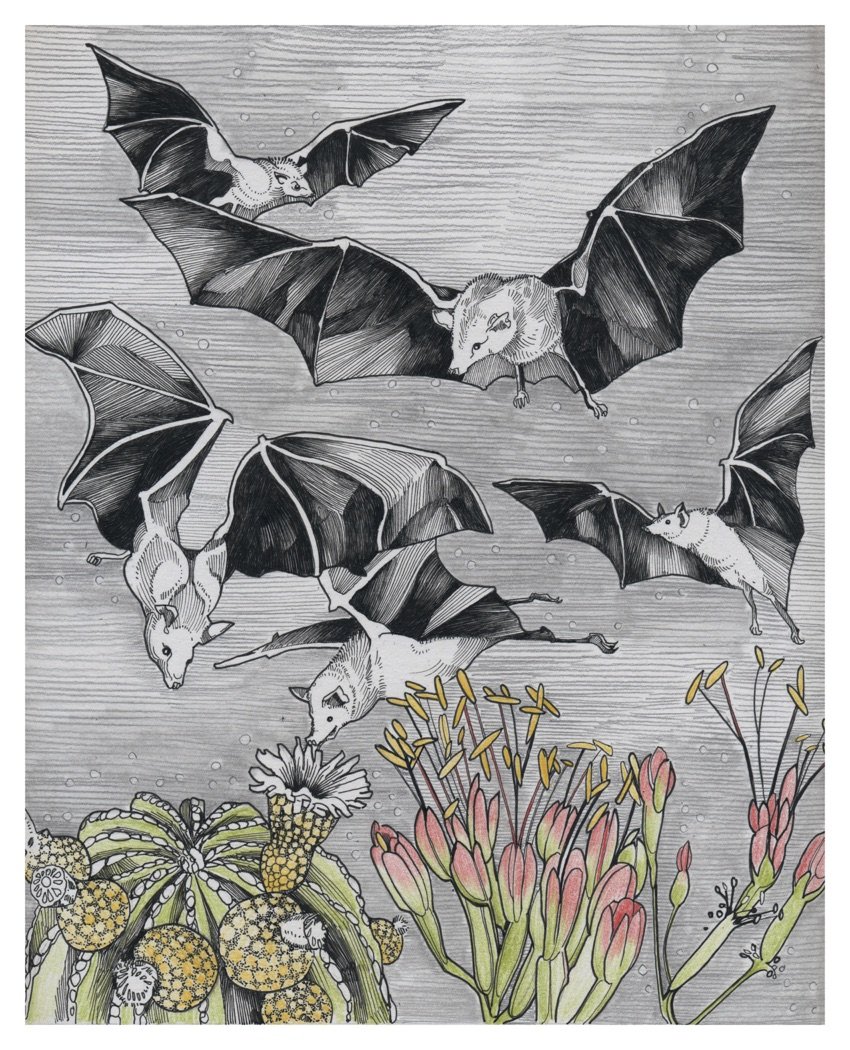BATS 8" x 10" print
“Science asks us to learn about organisms. Traditional knowledge asks us to learn from them”.
-Robin Wall Kimmerer
This artwork is from a 2022 wall calendar project and is exploring how change happens in the more-than-human world. What is the pace? What is the scale? The catalysts, the intelligence, the resources? The plants and animals are powerful teachers and offer abundant examples of how, specifically, to practice a cooperative, interconnected life. Here I explore examples of Pollination (sharing), Metamorphosis (forming), Germination (growing), and Decomposition (Dying). Each monthly page includes a few questions about how these examples might translate to human experiences.
Pollination: MOVEMENT. BATS. “There are more than 530 species of flowering plants that rely on bats as either their major or exclusive pollinators.” (Bat Conservation International). Pollination is a vital part of all life on earth and many different creatures are responsible for it. Bats are able to travel greater distances than most insects and birds so they fill the role of long-distance pollen dispersers. If you think of pollen as a metaphor for resources and ideas, who or what creates, uses, and/or shares these resources in your communities? How are they dispersed?
“Science asks us to learn about organisms. Traditional knowledge asks us to learn from them”.
-Robin Wall Kimmerer
This artwork is from a 2022 wall calendar project and is exploring how change happens in the more-than-human world. What is the pace? What is the scale? The catalysts, the intelligence, the resources? The plants and animals are powerful teachers and offer abundant examples of how, specifically, to practice a cooperative, interconnected life. Here I explore examples of Pollination (sharing), Metamorphosis (forming), Germination (growing), and Decomposition (Dying). Each monthly page includes a few questions about how these examples might translate to human experiences.
Pollination: MOVEMENT. BATS. “There are more than 530 species of flowering plants that rely on bats as either their major or exclusive pollinators.” (Bat Conservation International). Pollination is a vital part of all life on earth and many different creatures are responsible for it. Bats are able to travel greater distances than most insects and birds so they fill the role of long-distance pollen dispersers. If you think of pollen as a metaphor for resources and ideas, who or what creates, uses, and/or shares these resources in your communities? How are they dispersed?
“Science asks us to learn about organisms. Traditional knowledge asks us to learn from them”.
-Robin Wall Kimmerer
This artwork is from a 2022 wall calendar project and is exploring how change happens in the more-than-human world. What is the pace? What is the scale? The catalysts, the intelligence, the resources? The plants and animals are powerful teachers and offer abundant examples of how, specifically, to practice a cooperative, interconnected life. Here I explore examples of Pollination (sharing), Metamorphosis (forming), Germination (growing), and Decomposition (Dying). Each monthly page includes a few questions about how these examples might translate to human experiences.
Pollination: MOVEMENT. BATS. “There are more than 530 species of flowering plants that rely on bats as either their major or exclusive pollinators.” (Bat Conservation International). Pollination is a vital part of all life on earth and many different creatures are responsible for it. Bats are able to travel greater distances than most insects and birds so they fill the role of long-distance pollen dispersers. If you think of pollen as a metaphor for resources and ideas, who or what creates, uses, and/or shares these resources in your communities? How are they dispersed?
